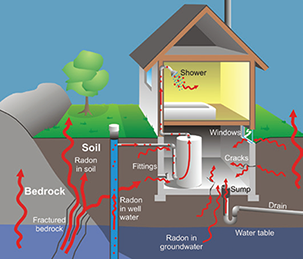Radon in Indiana
The state of Indiana, like the majority of states in the US, has levels of radon present that you should be aware of.
While Radon is a dangerous gas that can cause illness – and be lethal – when highly concentrated, it can also be treated easily.
Here is everything you need to know about radon in Indiana!
Indiana Radon Levels
The recorded average level of radon in the state of Indiana is 7.2 pCi/L.
This is below the national average radon level, which was last recorded at 7.6 pCi/L. However, overall this is still very high.
U.S. The Environmental Protection Agency says that 4 pCi/L is the highest level that it should be at inside of your home.
How Do I Know if My Home Has Radon?
Unfortunately, radon is undetectable without testing equipment. Radon is a tasteless, odorless and invisible gas.
The only way to know if your home has radon levels present is to get a radon inspection from a certified radon inspector.
However, if you don’t get an inspection, you will likely know if your home has radon after a while because you will be very ill, and there is a chance of death if the radon is not fixed.
How is Radon Getting Into My Home?
- The gas is made beneath the Earth’s surface naturally when uranium breaks down.
- The breakdown process creates radon gas as part of the decaying process.
- The gas then needs to escape through the soil & into the atmosphere.
- If the gas cannot escape into the air, it will dissolve into water in the soil, and then escape into the air when the water is able to flow on the surface of the soil.
Typically, the gas is able to escape into the air and dissipate, either through water or through the air.
- However, when there is a home built into the soil where the radon is trying to escape from, it is trapped and will seep through the foundation of the home and then release indoors.
- It may also dissolve into water lines used for your home, and then release whenever you turn on water (sinks, washing machines, showers, etc.).
Since homes are a confined area, the radon will keep evaporating into the home from the ground, but won’t be able to dissipate into the atmosphere like it usually would.
This results in the gas becoming more and more concentrated inside of your home as more radon is produced from the decomposition process. Since the gas cannot fully dissipate, the air in your home becomes highly concentrated and toxic.
How to Reduce Radon Levels
Although radon is impossible to detect and is very dangerous, it is actually very easy to get rid of, or reduce.
When you get a radon inspection, the inspector will determine how high the levels of radon are in the air inside of your home. If you have levels above 4 pCi/L, then you will need to have a radon mitigation system installed.
The mitigation system will redirect the gas from the soil under your home and create an alternate pathway to allow the gas to escape outside of your home and safely into the open air.
Once this system has been installed, the air in the home will be free of concentrated levels of radon and you have nothing to worry about! However, you should have this mitigation system checked regularly to ensure that it is doing its job!
Even if your home already has a mitigation system intact, it is a good idea to get a radon inspection every couple years to ensure that the system is working properly and your home’s air is safe to breathe!




